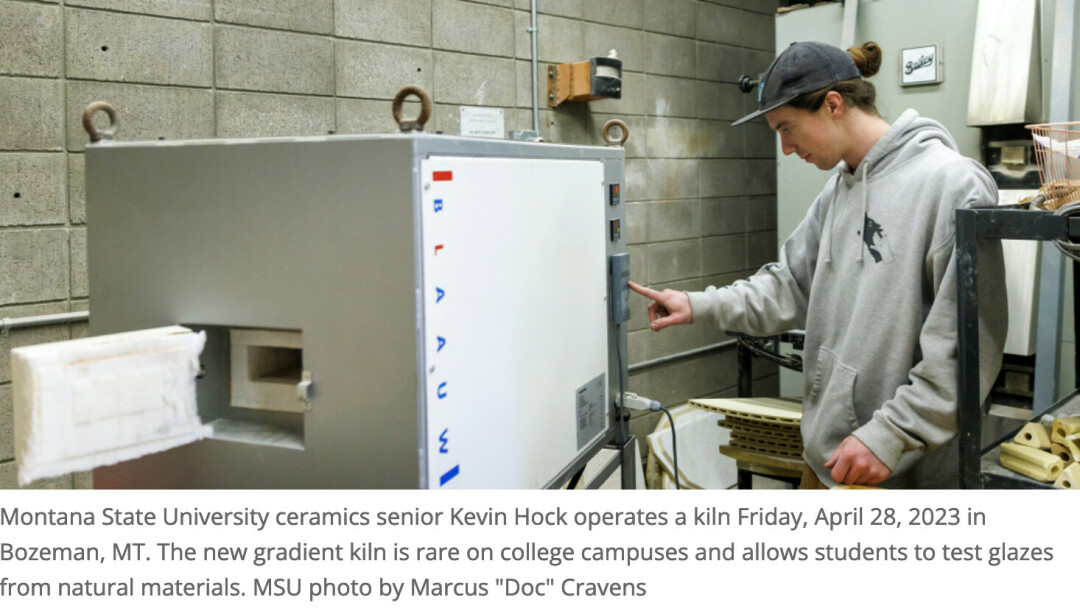High-end kilns help Montana State University ceramics students rock projects
Thursday May. 18th, 2023

BOZEMAN — Kevin Hock likes rocks. He likes the way they look under flowing water. He also likes to find them, smash them and make them.
The Montana State University ceramics major even has an exhibit on campus, displaying artwork he made from local rocks, an exhibit that has benefitted from a few new tools in the College of Arts and Architecture that have helped Hock and others develop their craft more quickly and efficiently.
In late 2020, the ceramics program acquired three new kilns — oven-like machines that produce high enough temperatures to harden, dry or chemically change objects made from clay — from the Dutch company Blaauw. The gas-powered machines are controlled by computers, which makes them easy to use and programmable to within a degree of temperature.
“They’re incredibly efficient and incredibly accurate,” said Josh DeWeese, ceramics professor and director of MSU’s School of Art. “They’re very predictable. We know what we’re going to get each time.”
Common clays used in ceramics need to be fired at 2,000 to 2,300 degrees Fahrenheit to set and harden. The new kilns can be started in the evening, perform their task overnight and cool off by morning, according to DeWeese.
That process would take about three days when using a different model gas-fired kiln, DeWeese said. He also said the new kilns use about a quarter of the energy as other kilns, making them more cost and energy efficient.
“The new kilns give us the capability to fire more frequently, which gives students the ability to learn more about the process, get results quicker and make adjustments,” DeWeese said.
Two of the Blaauw kilns are large machines used to set clay.
The third is called a gradient kiln, which is used for testing materials. Administrators in the art school said they know of only one other U.S. college that has a Blaauw gradient kiln.
The ceramics department acquired the kilns through MSU’s Humanities, Arts and Social Sciences Grant Program for the International Wild Clay Research Project, which studies wild, local materials used in ceramics and was co-founded by DeWeese.
Hock, who thought about also majoring in geology, said the project has helped him focus his work.
“Rocks are a cool tool to learn about different geological processes that form our landscape,” he said.
A shelf at his workstation holds a stack of tiles, each about 2 inches wide and 19 inches long. The tiles are coated in glazes that get darker from left to right, resembling paint color strips. They are test pieces for glazes Hock has created.
The process starts with finding rocks – Hock is currently working with basalt and granite from the Yellowstone River.
He smashes those rocks with a hammer, a process Hock describes as “a soothing stress reliever.”
Then, he heats the stones and transfers them to a ball mill, where they are grinded down. The resulting powder is made into a paste, which becomes the glaze.
The glaze is applied to a strip of tile, which is then inserted into the side of the gradient kiln. The kiln heats sections of the tile to different temperatures, causing the glaze to react differently, which produces variations in color and sheen.
“It’s been a great resource to quickly test materials and find out what temperature they work at,” Hock said.
He uses these glazes on the mugs, bowls and ceramic rocks that sit on a shelf adjacent to his test tiles.
Some of those items were part of a portfolio he put together to win the Cory and Diane Pulfrey Ceramics Scholarship. The scholarship awarded him $2,500, which he said will go toward tuition, allowing him more time to explore rivers and mountains in search of new materials instead of working at a bakery.
To accompany the scholarship, Hock has an exhibit in the Dean’s Gallery at Cheever Hall. His piece is a pile of what appear to be shiny, multicolored river rocks but are actually ceramic creations.
“I’ve chosen just to make rocks out of rocks,” he said. “But I’m really glad it’s fooling people.”
Hock plans to graduate in the fall of 2023, but in the meantime is excited to split his time between nature and the ceramics lab.
“I’m really looking forward to this summer,” Hock said. “I’m excited to have more time to research and test new materials.”
| Tweet |